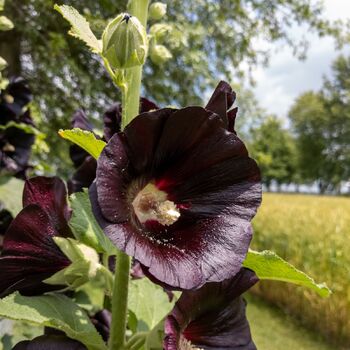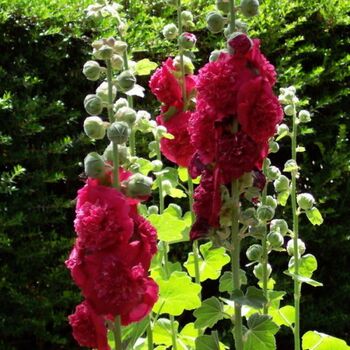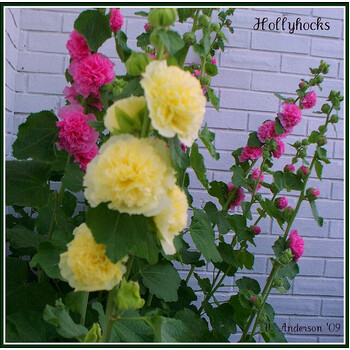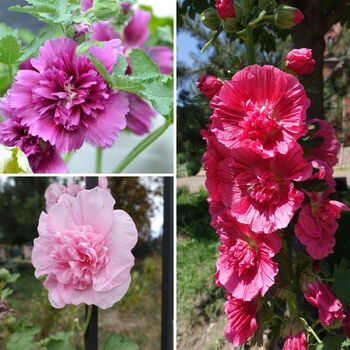
How to Grow Hollyhock Seeds
Grow Guide #2355
Family: Malvaceae
Binomial name: Alcea rosea
Life Cycle: Perennial (often grown as an annual)
This 'How to Grow' guide details everything a home gardener needs to know to plant, grow and care for Hollyhock (Alcea rosea).
When to Sow Hollyhock Seeds
Use the table below to identify the best time of year to sow hollyhock seeds in your climate.
| JAN | FEB | MAR | APR | MAY | JUN | JUL | AUG | SEP | OCT | NOV | DEC | |
|---|---|---|---|---|---|---|---|---|---|---|---|---|
| Cool | ||||||||||||
| Temperate | ||||||||||||
| Sub-Tropical | ||||||||||||
| Tropical | ||||||||||||
| Arid |
Preparation
Hollyhock plants are best grown in full sun. Choose a location that will receive at least 6 hours of full sun each day.
Hollyhock plants are short-lived perennials, meaning they usually live for between two and five years. Choose a permanent position where plants can grow undisturbed by regular digging or disturbance.
Hollyhock plants commonly self-seed in the garden. Self-seeding plants drop seeds onto the soil at the end of the season that may germinate and grow without help the following season. Choose a position where new plants will be welcome. If you do not want hollyhock to become established in your garden, deadhead plants before they can drop seed or grow them in containers.
Hollyhock plants need a well drained soil enriched with plenty of organic matter. Prepare soil by weeding it thoroughly, digging it over to loosen it and adding aged animal manure or compost. Keep the area free of weeds until planting. Learn more about preparing soil for planting here.
How to Sow Hollyhock Seeds
Hollyhock seeds do not require any treatment (eg soaking, stratification) before sowing.
Hollyhock seeds grow best when they are raised in trays or other containers and transplanted to the garden once established.
- Fill trays, punnets or jiffy pots with a good quality seed-raising mix, or use soil starter pellets.
- Sow seeds 6mm deep.
- Keep soil moist but never wet or dry.
- Seeds should germinate in around 10-14 days at a soil temperature of 18-28°C.
- Transplant seedlings to the garden once they have their first true leaves and are large enough to handle (usually 5-10cm tall).
- Plant out, spacing plants 40cm apart.
Tip: Hollyhock seeds can also be sown in the less formal ‘scatter seed’ method. Simply roughen the soil, scatter seeds evenly over the surface, then smooth the soil over lightly to cover the seeds.
How to Grow Hollyhock
Hollyhock plants may need watering during the growing season. Water when the soil is dry about 5cm below the surface (test this by scratching away a little soil with your finger). Water deeply in the early morning or late afternoon. Avoid watering the leaves of plants to avoid fungal diseases. Learn more about watering here.
If soil was well prepared no extra fertiliser should be necessary. In poor soil or to give your plants an extra boost, application of a high-potassium fertiliser or one formulated for flowering plants can be beneficial:
- Apply slow release fertiliser at the recommended rate when transplanting or when seedlings are 5-10cm tall.
- Apply liquid fertiliser at the recommended rate and frequency while plants are fruiting or flowering.
Hollyhock plants may need to be supported as they grow. Depending on the expected size and height of the plant, use a stake, bamboo cane, trellis or string lines to support plants. Make sure you have the support in place when you sow seed or transplant seedlings to avoid disturbing the plant's roots later.
Hollyhock plants should flower in approximately 150-200 days.
Deadhead hollyhocks regularly during the growing season. Using sharp secateurs or snips cut entire flower stems at ground level. Removing old flower spikes will encourage plants to produce more flowers. Learn more about deadheading flowering plants here.
To grow hollyhocks as perennials, cut flower stems at ground level after flowering and prune off all dead foliage in winter.
Common Problems when Growing Hollyhock
Like all plants, hollyhock is susceptible to some pests, diseases and other problems. Below is a list of the most common problems gardeners encounter when growing hollyhock plants:
 Armyworms, cutworms and other caterpillars can all eat the buds or flowers. Young caterpillars burrow into the buds, eating the petals so flowers do not open properly, or consuming the seeds once the flower has matured. Monitor plants and remove any caterpillars you see. If necessary use insect exclusion netting to physically protect the plant, or spray with Dipel.
Armyworms, cutworms and other caterpillars can all eat the buds or flowers. Young caterpillars burrow into the buds, eating the petals so flowers do not open properly, or consuming the seeds once the flower has matured. Monitor plants and remove any caterpillars you see. If necessary use insect exclusion netting to physically protect the plant, or spray with Dipel. Rust (Puccinia sp.) is a fungal disease that causes brown to orange raised spots or patches to appear on foliage. Fungal spores are spread by wind or water to neighbouring plants, especially in temperatures of 10-20C and when humidity is high. To manage rust, space plants to avoid overcrowding, grow them in the recommended amount of light (eg full sun), do not over fertilise crops, remove dead plants and practice crop rotation. Read more about rust fungus here.
Rust (Puccinia sp.) is a fungal disease that causes brown to orange raised spots or patches to appear on foliage. Fungal spores are spread by wind or water to neighbouring plants, especially in temperatures of 10-20C and when humidity is high. To manage rust, space plants to avoid overcrowding, grow them in the recommended amount of light (eg full sun), do not over fertilise crops, remove dead plants and practice crop rotation. Read more about rust fungus here. Slugs and snails are molluscs that feed on tender leaves and shoots, mostly at night, leaving slimy trails behind them. Control them by removing their hiding places, keeping free range poultry, collecting them by torchlight or by placing traps. Read more about slugs and snails here.
Slugs and snails are molluscs that feed on tender leaves and shoots, mostly at night, leaving slimy trails behind them. Control them by removing their hiding places, keeping free range poultry, collecting them by torchlight or by placing traps. Read more about slugs and snails here.


.png)






